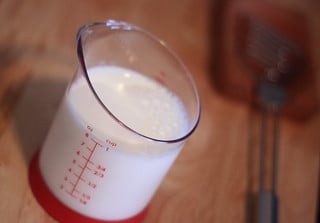Understanding volume conversions is essential in many aspects of life, from cooking and baking to home improvement projects and even understanding math problems. When it comes to liquid measurements in the United States, knowing the relationship between pints and gallons is a fundamental conversion.
So, How Many Pints Are In A Gallon? The answer is straightforward: there are 8 pints in 1 gallon. This article will delve into this conversion, explore the US customary system, provide helpful charts, and offer memory tips to make these liquid measurements easy to remember.
US Customary Units: Pints, Gallons, and More
In the United States, we primarily use the US customary system for measurements, which is a variation of the imperial system. This system includes units like gallons, quarts, pints, cups, fluid ounces, and more for liquid volume. It’s important to note that while the US system is rooted in the imperial system, there are some key differences, particularly in liquid measurements.
For instance, a US pint is slightly smaller than a British imperial pint. While this difference might seem minor, it’s crucial to be aware of it, especially when following recipes or dealing with measurements from different countries. Therefore, when we discuss “how many pints in a gallon” in this article, we are specifically referring to the US customary gallon and pint.
Decoding the Gallon to Pint Conversion
The core conversion to remember is:
1 gallon (gal) = 8 pints (pt)
Conversely, this means:
1 pint (pt) = 1/8 gallon (gal)
Imagine you have a gallon of your favorite juice. That gallon is exactly the same as having eight individual pints of juice. Similarly, if you only need half a gallon of something, that would be equivalent to 4 pints (since 4 is half of 8).
To make these conversions even clearer, here’s a handy conversion table:
| Gallons (gal) | Pints (pt) |
|---|---|
| 3 | 24 |
| 2 | 16 |
| 1 | 8 |
| 1/2 | 4 |
| 1/4 | 2 |
| 1/8 | 1 |


As you can see from the table, converting gallons to pints is a simple process of multiplying the number of gallons by 8.
Example: Let’s say you need to figure out how many pints are in 1/4 of a gallon of iced tea.
Calculation: (1/4 gallon) * 8 pints/gallon = 2 pints
Therefore, 1/4 gallon is equal to 2 pints.
If you need to go the other way and convert pints to gallons, you simply divide the number of pints by 8.
Example: Imagine you have 16 pints of soup and want to know how many gallons that is.
Calculation: 16 pints / 8 pints/gallon = 2 gallons
So, 16 pints is equal to 2 gallons.
In summary, there are 8 pints in a US gallon. And to answer another common question, there are 4 pints in a half gallon (half of 8).
But pints and gallons aren’t the only liquid measurements in the US customary system. Let’s explore the relationships between other units like quarts and cups.
A glass measuring cup accurately filled with fresh milk to demonstrate liquid volume measurement.
Navigating the US Liquid Measurement Chart: Gallons, Quarts, Pints, and Cups
Beyond gallons and pints, the US customary system includes quarts and cups, creating a hierarchy of liquid volume measurements. Understanding how these units relate to each other is key to mastering liquid conversions.
Here are the fundamental relationships:
- 2 cups (c) = 1 pint (pt)
- 2 pints (pt) = 1 quart (qt)
- 4 quarts (qt) = 1 gallon (gal)
This expands our conversion knowledge and allows us to create a more comprehensive conversion chart:
| Gallons (gal) | Quarts (qt) | Pints (pt) | Cups (c) |
|---|---|---|---|
| 1 | 4 | 8 | 16 |
| 3/4 | 3 | 6 | 12 |
| 2/3 | 2 2/3 | 5 1/3 | 10 2/3 |
| 1/2 | 2 | 4 | 8 |
| 3/8 | 1 1/2 | 3 | 6 |
| 1/3 | 1 1/3 | 2 2/3 | 5 1/3 |
| 1/4 | 1 | 2 | 4 |
| 1/6 | 2/3 | 1 1/3 | 2 2/3 |
| 1/8 | 1/2 | 1 | 2 |
| 1/16 | 1/4 | 1/2 | 1 |
This chart provides a quick reference for converting between gallons, quarts, pints, and cups. While memorizing this entire chart might seem daunting, you can simplify things by focusing on key conversion factors.
Simple Tricks to Remember Liquid Measurement Conversions
Instead of trying to memorize the entire chart, focus on these three essential conversion rules:
1. Gallons to Pints: Multiply by 8
As we’ve emphasized, to convert gallons to pints, simply multiply the number of gallons by 8. And conversely, to convert pints back to gallons, divide the number of pints by 8.
This is the most crucial conversion for answering “how many pints are in a gallon,” and it’s the foundation for many other liquid measurement calculations.
2. Gallons to Quarts: Multiply by 4
Quarts are larger than pints, and there are fewer quarts in a gallon than pints. Specifically, there are 4 quarts in 1 gallon.
To convert gallons to quarts, multiply the number of gallons by 4. To convert quarts to gallons, divide the number of quarts by 4.
A helpful memory trick: Think of a gallon as being made up of four “quarters,” which sounds like “quarts”!
Three quarts of liquid placed together to visualize the volume of a quart measurement.
3. Quarts to Pints and Pints to Cups: Multiply by 2
For the conversions between quarts and pints, and pints and cups, the magic number is 2.
- To convert quarts to pints, multiply by 2.
- To convert pints to cups, multiply by 2.
Similarly, to convert in the opposite direction:
- To convert cups to pints, divide by 2.
- To convert pints to quarts, divide by 2.
You can remember this by recognizing the pattern: 2 cups make a pint, and 2 pints make a quart. Adding these “2s” together (2 pints/quart + 2 quarts/half gallon) conceptually leads to the “4” in 4 quarts per gallon, and doubling that (4 quarts/gallon * 2 pints/quart) gives you the “8” in 8 pints per gallon.
Ready to Master Liquid Conversions?
Understanding “how many pints are in a gallon” and the relationships between other US customary liquid units is a valuable skill. By remembering the key conversion factors of 8, 4, and 2, and utilizing the charts provided, you can confidently navigate liquid measurements in recipes, projects, and everyday situations.
Want to expand your measurement knowledge? Explore resources on converting teaspoons to tablespoons or understanding quarts to cups conversions to further enhance your understanding of US customary units.
